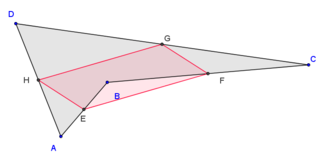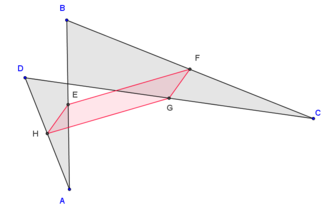Varignon's theorem
Appearance

Varignon's theorem is a statement in Euclidean geometry that was first published by Pierre Varignon in 1731. It deals with the construction of particular parallelogram (Varignon parallelogram) from an arbitrary quadrangle.
- The midpoints of the sides of an arbitrary quadrangle form a parallelogram. If the quadrangle is convex or reentrant, i.e. not a crossing quadrangle, then the area of the parallelogram is half as big as the area of the quadrangle.
If one introduces the concept of oriented areas for n-gons, then the area equality above holds for crossed quadrangles as well.[1]
| convex quadrangle | reentrant quadrangle | crossed quadrangle |
|---|---|---|
References
- ^ Coxeter, H. S. M. and Greitzer, S. L. "Quadrangle; Varignon's theorem" §3.1 in Geometry Revisited. Washington, DC: Math. Assoc. Amer., pp. 52–54, 1967.




